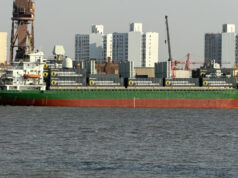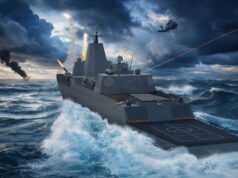For the third time in two months, the Royal Navy has kept a constant eye on a Russian naval force passing the UK.
Patrol ship HMS Mersey and a Wildcat helicopter from RNAS Yeovilton were dispatched to follow the progress of three Russian warships/vessels as they made their way up the Channel.
The Russian spy ship Feodor Golovin, landing ship Alexander Ostrakovskiy and tanker Yelnya have been supporting Russian operations in Syria and are believed to be returning to their base ports in the Baltic and Barents seas.
Portsmouth-based Mersey and her 34 crew broke off from a regular fishery protection patrol in home waters and sailed to meet the Russian trio as they approached the Channel, taking over from the French Navy which has monitored the task group’s progress through the Bay of Biscay.
The patrol ship has spent 72 hours tracking the Russians as the vessels made their way into the North Sea, handing over to the Dutch Navy once the three ships had passed through the Strait of Dover.
“Ships like HMS Mersey are the eyes and ears of the Royal Navy around the UK – we are at sea for 320 days a year, so Mersey provides the Navy with a ship ready to respond at short notice like this,” said Lieutenant Alexandra Karavla, the patrol ship’s Executive Officer.
“Although her routine business is patrolling UK waters and helping to enforce fishery legislation, HMS Mersey was tasked to locate, meet and escort the ships through the English Channel.
In this we have been well supported by a Royal Navy Wildcat from 815 Naval Air Squadron and by NATO colleagues. Operations like this would not be possible without such support and co-operation.
This tasking proves why HMS Mersey is vital to UK Defence. The flexibility and options these offshore patrol vessels provide to the Government is evident in the variety of tasking undertaken.”
Able Seaman Ryan Flynn is one of the warfare specialists who has been tracking the Russian ships’ progress.
“Exciting operations like these are why I joined the Royal Navy,” he said. “I love these ships because one day I will be conducting a fishery protection boarding and the next day I will be following Russian warships off the South Coast. It’s the best job in the world!”
At the beginning of the year, frigate HMS Westminster was activated to keep track on the activities of two Russian frigates and their support vessels returning to the Baltic after operations in the Middle East, while HMS St Albans’ Christmas was interrupted by a mission to monitor the new Russian warship Admiral Gorshkov.














Shouldn’t we have more than an OPV escorting 3 ships or were none available
Can we assume the spy ship was listening as she transited our area of interest? I wonder what regular contributor FP has to say about that!
We escort ships through the channel with whatever is available. Yes it would be better from a media prospective if we sent a destroyer out but we work with what we have. There is zero threat from the Russian ships, we are not at war. An escort in the channel is just NATO saying we see you there friend.
Another thing, most of the time the Russian naval groups moving through the channel could mop the floor with our escorts. A frigate is not going to do anything against a battlecruiser and a Russian aircraft carrier, which is basically a cruiser that carries aircraft.
Would also add that the current group was a spy ship, landing ship and a tanker. A OPV, backed up by a helicopter is more than suited in this instance. It was also reported that France had a MPA in the channel.
As far as active escorts go, in the last day or so. Destroyer HMS Duncan is in the Black sea and, HMS Diamond and HMS Dragon have been active in the English channel. We have frigates HMS Sutherland in Australia, HMS Westminster in Norway, HMS Argyll is somewhere in the channel doing FOST, HMS Montrose off Scotland, HMS St Albans getting ready to go out and HMS Somerset in Gibraltar/off Spain. These are just the ones that have had snippets reported about them, I am sure there are more active.
Probably. In the Cold War they used fishing boat type vessels to follow NATO ships around.
There was the infamous incident involving the Gaul which may have been a spy vessel used by the RN.
So the Russians sailed by peacefully and without threats. So these are the people British warmongers want to antagonize. With 7000 nukes and 2m men you will certainly hold out 20 mins. If the Russians had not conquered the German army in WWII, the English would now be speaking German again. Thank this great Christian nation for its restraint.
No – we are not at war.
There were frigates escorting in December and January….I suspect none available in february
Although I agree that principle should be any warship group passing through the channel should be met by a frigate/ destroyer in this instance as no 1st class warships were present then a River class OPV is a suitable response. This is a good example of why we need to retain the river class batch 1s. They will help provide a vital critical mass and adequate patrol numbers.
In the future the RN will only have enough escort warships if they build 10 or more type 31s and ideally reverse the decision to only build 8 type 26s. The defence select committee and RN themselves state categorically that the RN needs an escort warship fleet of 26 hulls just to match current peacetime commitments and deployments.
Agree with Mr Bell.
Media hysteria. Maybe the Russians shouldn’t go to their home ports lol
An OPV is fine, as much as anything it’s to make sure they don’t fly-tip any plastic straws.
I think we are beginning to see how the River 2’s will be deployed. This report is not the first time absent a frigate we have deployed an OPV plus a Wlidcat for these escort duties. A River 2 can land, refuel and rearm a Wildcat for several days. The helos speed, range, Sea Spray radar, sensor package and Sea Venom are tremendous force multipliers to the 30mm on the River. The whole package is more than enough to send a ‘keep off the grass’ message.
SSNs sink large ships, Destroyers cover AAW and Frigates ASW, OPVs provide presence, boarding capability and host SF
I understand. I would think the Wildcat is being used mainly for its radar.
That said its good to know it can do more, especially considering the growth in Russian corvette numbers.
As a side note looks like the Spyship has a more potent arnament than HMS Mersey (2 x kashtan ciws) but seriously this shortfall in hulls can have been avoided if the right decisions were taken 20 years ago.When the Type 23’s were building and the last one completed we should have scaled back production and built say 1 ship every 3 years subsequently – with incremental improvements incorporated into the process such as they have now – Kryten main gun/Sea Ceptor etc.That way all the Frigates would be relatively young in Hull life,once they served 15 years or so in the fleet they could be sold on to Allies as they are now.The ships that are now the River class OPV should have been today what we are proposing as the Type 31,surely a better vessel for escort duties in the Channel but hey-ho like has been said we work with what we have.
On another issue-whats with the rounded Bow on the Batch 2 OPV’s? The sharp Bow of the Batch 1’s certainly looks more menacing even if she does lack teeth.
Dunno, one for the naval architects. I suspect the sharp bow lines of the River 1 provide good sea keeping but create a lot of drag when you increase the top speed to the 24knots of the River 2.
It’s still better than what we could muster against the ‘Channel Dash’.
Russia regarded as our allies TH?
You have to be on the Kremlin’s pay roll.
Yes Putin’s Russia are very friendly. Invading Ukraine, Georgia and exerting threatening pressure on the democratic and free Baltic states.
Meanwhile recent submarine and aircraft incursions into UK space is definetly an act of friendliness. You are either a Russian writing away from the basement of the Kremlin or a complete Muppet TH. Which is it? Russian or stupid?
Muppet it is. Like the Russians would hire an idiot.
Yeovilton is not ideally placed for a ‘quick reaction alert’ interception in the North Sea. It is the best part of 200 miles to Dover or Ipswich for example. Wiki lists the range of the Wildcat at just over 400 miles. When we have the River 2’s it would be able to refuel at sea which would extend its range and endurance.
Yes or just forward deploy to an eastern airfield.Via NATO we would know if ships are heading this way.
The photo shows the OPV and the Russian ship in close proximity. I’m assuming this only happens in the Dover straits. Or does this close supervision start futher into the North Sea.
Depends on the vessel being escorted.
I did an escort job when on a T42 shadowing a Soviet era Kirov Battlecruiser. We picked it up in the western approaches and then escorted it right the way up to the top of Norway.
Thx
Radar and drones give far more practcal cover. The trouble with covering the channel transit with the RN is that when you start with destroyers and end up with river launches the Russian furure planning would be countering rowboats. Get with reality, the threat from the Russian navy is not from the channel!
This would be perfect for the Type 31E Corvettes if they ever get built..
Can’t believe you mentioned the C word, there’s children watching this site!